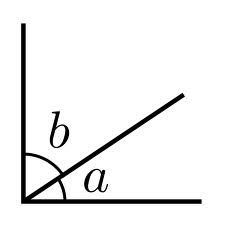7 Maths 5 lines and angles part 1
Introduction
Line
A line is infinite and straight. A line is a set of continuous points that extend indefintely in either of its direction
Line Segment
A line segment is a straight line segment which is part of the
straight line between two points. To identify a line segment, one can
write AB or .
The points on each side of the line segment are referred to as the end points.
Ray
A ray is the part of the line which consists of the given point
and the set of all points on one side of the end point.
A is the end point and this ray means that all points starting from A are included in in the ray. A ray can also be written like:
(Source- mrudula, 4-6-13 , Lines, Ray and Line Segments)
Angle
An angle is formed when two rays (AB and AT) share a vertex (point A).
• The two rays are the sides of the angle.
• The interior of an angle is the set of all points between the sides of the angle.
• The exterior is the set of all points outside the angle.
Exercise : http://www.ck12.org/geometry/Congruent-Angles-and-Angle-Bisectors/exerciseint/Angles-and-Algebra/
Exercise : http://www.ck12.org/geometry/Congruent-Angles-and-Angle-Bisectors/exerciseint/Total-Angle/
Types of Angles
Angles can be grouped into four different categories.
Straight Angle: An angle that measures exactly 180 deg.

Acute Angles: Angles that measure between 0 deg and up to but not including 90 deg.

Obtuse Angles: Angles that measure more than 90 deg but less than 180 deg.

Right Angle: An angle that measures exactly 90 deg.

This half-square marks right, or 90 deg, angles. When two lines intersect to form four right angles, the lines are perpendicular.

Even though all four angles are 90 deg only one needs to be marked with the half-square.
(source- mrudula, 13-6-13, Lines and Angles)
Example A
What type of angle is 84 deg?
84 deg is less than 90 deg, so it is acute.
(source- mrudula, 13-6-13, Lines and Angles)
Related Angles:
Complementary Angles:

Two angles are complementary if they add up to 90 deg. Complementary angles do not have to be congruent or next to each other.